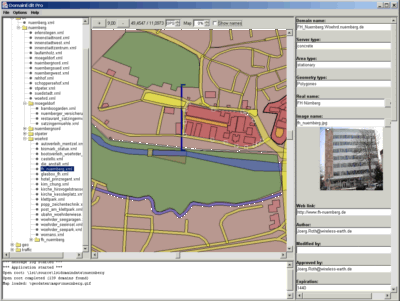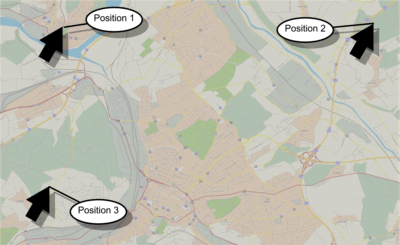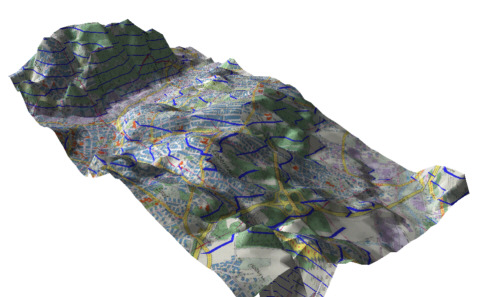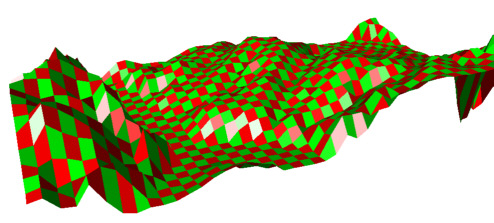| |
Goal of Hybris is to build the foundation of innovative location-based services. We observed in
the predecessor project Nimbus that issues related to geo data and locations cannot
be handled in an ad-hoc manner. In the Hybris project we thus want to investigate the following, strongly related areas:
- modelling of geo data for location-based services;
- inferring position knowledge;
- modelling of position data that base on uncertain position sensors.
The following tools have been developed so far:
- the geo data editor depro (description and download see below)
- a simulator for location sensors
- a method to infer location knowledge: MAP3
With the geo data editor depro ("domainedit pro") a user can create and edit geo objects (so-called domains). The idea is based on the Nimbus project, but depro domains can be used for other projects as well. Domains can be geometrically described by multipolygons with holes, line strings or single points. Meta data such as descriptions, images and URLs can be attached. Domains can be classified according to hierarchical types.
Topological links between domains can be expressed (that are necessary for, e.g., street navigation).
Geo objects are stored as an XML tree that easily can be processed by other programs.
Depro can import NMEA logs (created by GPS loggers) as well as TomTom POIs (.OV2 files).
An import mechanisms of files from the Open Streetmap Project is under development.
Google Earth files can be exported.
|
 |
To run the editor, we need
- the editor program: depro download incl. sample files
- a background image (e.g. from a satellite): A simple grid is available in the sample files, but arbitrary images can be used (e.g. from Google Earth). Only a world file is required (see remarks).
- An XML tree that holds the geo data. If you want to create own data, this tree initially is empty. A sample tree that models the nearer area of the Georg-Simon-Ohm University of Applied Sciences Nuremberg is stored in the sample files.
- The JTS library of vividsolutions. This library is required to compute polygonal operations. From this library we only need the Jar file jts-1.8.jar.
To run the program we need the Java runtime environment (JRE) (see java.sun.com). The command is
java -Xmx1000M -cp jts-1.8.jar;depro.jar pp.domaineditpro.depro -m Grid364x550.gif -r nuernberg
Here, we assume that the background image Grid364x550.gif, the XML tree nuernberg and the Jar files reside in the current directory. We get a short help for the command line options by
java -jar depro.jar -help
The geo data editor depro allows the integration of arbitrary background images (.gif, .jpg). The only requirement: the application has to map pixel coordinates to world coordinates.
For this, a World File (.twf) with the same name has to be available.
Some background images come along with a .twf files (e.g. orthophotos of land survey offices).
If no file is available, we can easily create it with the help of the following applet. For this, we
have to identify three points with known world coordinates. We can get the pixel coordinates from an image processing program. Geo coordinates can be read from grids inside the image or we use Google earth to reference known points.
To compensate measurement errors, the three points should have a large distance and span a large triangle. They must not lie on a single line.
|
 |
After this, we enter the coordinates in the following applet. The result can be stored in a .tfw file (which is a plain text file) via the clipboard.
The next applet can convert Gauss Kruger coordinates into WGS84 (lat/long or NMEA 0183 string).
With this applet we can examine a three-dimensional height profile.
To the applet...
The following list contains papers which are directly related to the Hybris project. A list of all publications of Jörg Roth can be found here.
Jörg Roth:
The Extended Split Index to Efficiently Store and Retrieve Spatial Data With Standard Databases
IADIS International Conference Applied Computing 2009, Rom (Italy), Nov. 19-21, 2009, Vol. I, ISBN 978-972-8924-97-3, 85-92
|
|
Jörg Roth:
Verwaltung geographischer Daten mit Hilfe eines Add-ons für Standard-Datenbanken
Verwaltung, Analyse und Bereitstellung kontextbasierter Informationen, GI Informatik 2009, Lübeck (Germany), Sept. 29, 2009, 2041-2055
|
|
Jörg Roth:
A Probabilistic Approach for Context Reasoning
Use In Context, GI Informatik 2008, Munich (Germany), Sept. 12, 2008
|
|
Jörg Roth:
Managing Geo Data for Location-based Services – The Hybris Framework
4th Annual Meeting on Information Technology & Computer Science (ITCS 2008), Stuttgart (Germany), Feb. 20, 2008, ISSN 1614-2519, 12-16
|

|
Jörg Roth:
Inferring Position Knowledge from Location Predicates
3rd International Symposium on Location- and Context-Awareness (LoCA 2007)
Sept. 20-21, 2007, Oberpfaffenhofen (Germany), LNCS 4718, Springer Verlag, 245-262
Nominated for the Best Paper Award
|

|
Jörg Roth:
Location Sensor Fusion Mechanisms – A Comparison
4. GI/ITG KuVS Fachgespräch "Ortsbezogene Anwendungen und Dienste", Sept. 13-14, 2007, Munich (Germany), Dr. Hut-Verlag, ISBN 978-3-89963-591-1, 17-21
|

|
Jörg Roth:
Modelling Geo Data for Location-based Services
3. GI/ITG KuVS Fachgespräch "Ortsbezogene Anwendungen und Dienste", Sept. 7-8, 2006, Berlin, Institute for Computer Science - Freie Universität Berlin, ISBN 3-929619-39-3, Sept. 2006, 20-25
|

|
Jörg Roth:
Detecting Identifiable Areas in Mobile Environments
The 21st Annual ACM Symposium on Applied Computing, April 23-27, 2006, Dijon, (France), ACM Press, 986-991
|

|
|

 This page
This page  email
email



